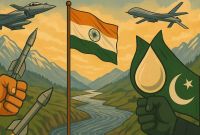A Journey to Bardia: The Terrifying Reality of Human vs. Tiger!

Joe Sills
The rustling sounds of the dry leaves along the banks of the Girwa River, which borders Bardia National Park, beckoned me to step outside my tent. The cheetah's calls were signaling something: a tiger was crossing the river. Gripping my telephoto lens like a club, I dashed towards the water, losing my sandals in the process.
I had been waiting for this moment for three days.
In the dry grass, I spotted a ranger’s shadow, signaling me to move forward.
Barefoot, I reached the bank of the Girwa River and saw fresh paw prints in the sand. This was why I had come here—to the edge of Bardia National Park, one of the last strongholds of the Bengal tiger. It’s one of the best places in the world to photograph a wild tiger. Finally, my moment had come.
But as a group of villagers began shouting from the opposite bank, I realized that this visit wasn’t just about taking pictures. It was harvesting season near Bardia, and the large tiger we were tracking might have just killed a woman who was cutting grass a little while ago. The villagers, armed with sickles, were warning us to stay back. They were cutting grass on their side and driving the tiger towards us.
The noise along the riverbank made it impossible to spot the tiger. And as we followed the tracks in the sand into the dense underbrush, the ranger I was with began to tell another story.
The Story of Conservation
Hemanta Acharya, who resides on the edge of Bardia and has worked with the World Wildlife Fund as a representative at the World Ranger Congress, recalls spending countless nights as a child listening to the sounds of tigers, rhinos, elephants, and leopards.
Far from the Himalayas, Bardia sees fewer tourists annually compared to other regions in Nepal. The 116,000 people living in Bardia’s buffer zone rely on the Community-Based Animal Protection Unit (CBAPU) led by Hemanta Acharya.
Currently, 2,000 volunteers are part of CBAPU in Bardia’s buffer zone, who monitor animal activities daily and record potential poaching activities. CBAPU also aims to educate local children about the wildlife in the jungle and reduce the risk of human-wildlife conflict.
Human-Wildlife Conflict
Hemanta Acharya’s father was killed by an elephant. Now, Hemanta has dedicated his life to conserving the very animals that took his father’s life. This journey of conservation is a profound struggle, where human and wildlife lives are constantly in conflict.
In Bardia, protecting rhinos, tigers, elephants, and other rare animals requires the support of the local community. Tourists who come to take pictures need to understand the reality of human-wildlife conflict here. They need to be motivated not only to capture images but also to respect the lives of the people who live here.
Conclusion
The reality of human-wildlife conflict in Bardia is profound. Addressing this conflict requires international support. It’s crucial that everyone contributes to resolving this struggle between humans and animals. Attention needs to be given not only to conservation efforts but also to the preservation of the lives of the people who coexist with these wild animals.
This article was published on Forbes.com and is subject to copyright. You can view the original article by clicking here.




![From Kathmandu to the World: How Excel Students Are Winning Big [Admission Open]](https://nepalaaja.com/img/70194/medium/excel-college-info-eng-nep-2342.jpg)
